FORD FESTIVA 1991 Service Manual
Manufacturer: FORD, Model Year: 1991, Model line: FESTIVA, Model: FORD FESTIVA 1991Pages: 454, PDF Size: 9.53 MB
Page 261 of 454
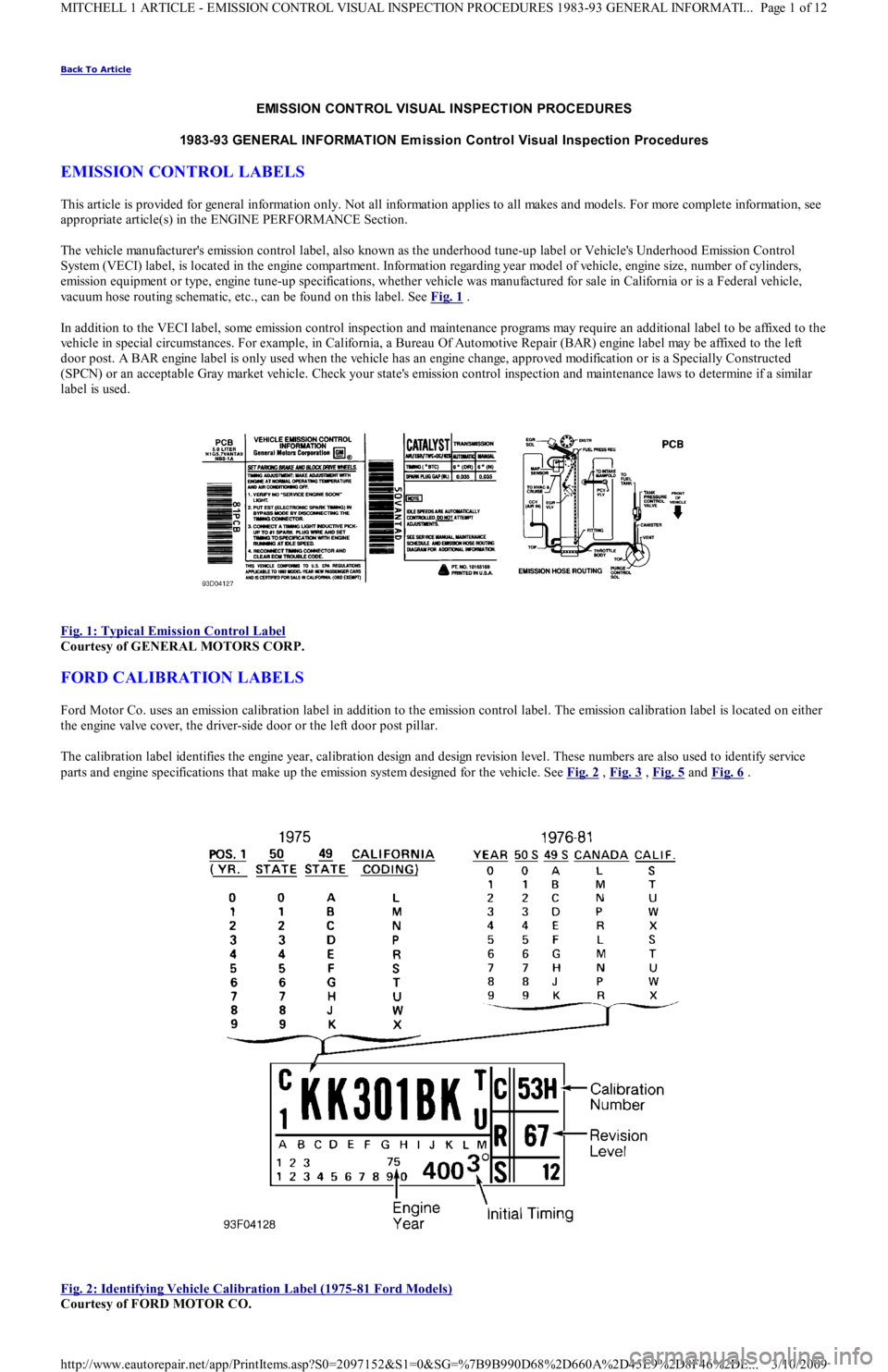
Back To Article
EMISSION CONT ROL VISUAL INSPECT ION PROCEDURES
1983-93 GENERAL INFORMAT ION Em ission Control Visual Inspection Procedures
EMISSION CONTROL LABELS
This article is provided for general information only. Not all information applies to all makes and models. For more complete information, see
appropriate article(s) in the ENGINE PERFORMANCE Section.
The vehicle manufacturer's emission control label, also known as the underhood tune-up label or Vehicle's Underhood Emission Control
System (VECI) label, is located in the engine compartment. Information regarding year model of vehicle, engine size, number of cylinders,
emission equipment or type, engine tune-up specifications, whether vehicle was manufactured for sale in California or is a Federal vehicle,
vacuum hose routing schematic, etc., can be found on this label. See Fig. 1
.
In addition to the VECI label, some emission control inspection and maintenance programs may require an additional label to be affixed to the
vehicle in special circumstances. For example, in California, a Bureau Of Automotive Repair (BAR) engine label may be affixed to the left
door post. A BAR engine label is only used when the vehicle has an engine change, approved modification or is a Specially Constructed
(SPCN) or an acceptable Gray market vehicle. Check your state's emission control inspection and maintenance laws to determine if a simil ar
label is used.
Fig. 1: Typical Emission Control Label
Courtesy of GENERAL MOTORS CORP.
FORD CALIBRATION LABELS
Ford Motor Co. uses an emission calibration label in addition to the emission control label. The emission calibration label is located on either
the engine valve cover, the driver-side door or the left door post pillar.
The calibration label identifies the engine year, calibration design and design revision level. These numbers are also used to identify service
parts and engine specifications that make up the emission system designed for the vehicle. See Fig. 2 , Fig. 3 , Fig. 5 and Fig. 6 .
Fig. 2: Identifying Vehicle Calibration Label (1975
-81 Ford Models)
Courtesy of FORD MOTOR CO.
Page 1 of 12 MITCHELL 1 ARTICLE - EMISSION CONTROL VISUAL INSPECTION PROCEDURES 1983-93 GENERAL INFORMATI
...
3/10/2009 http://www.eautorepair.net/app/PrintItems.asp?S0=2097152&S1=0&SG=%7B9B990D68%2D660A%2D45E9%2D8F46%2DE
...
Page 262 of 454
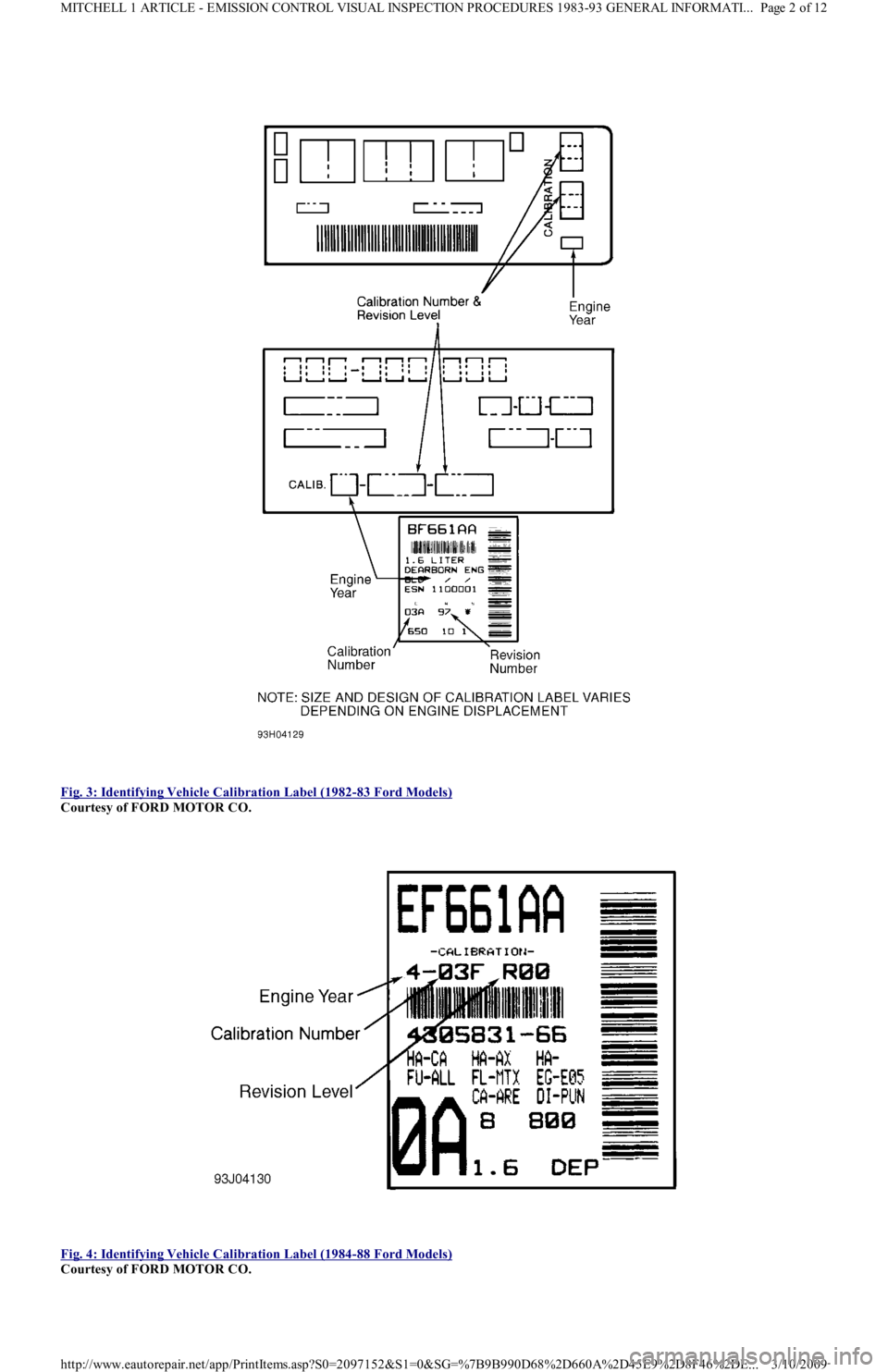
Fig. 3: Identifying Vehicle Calibration Label (1982
-83 Ford Models)
Courtesy of FORD MOTOR CO.
Fig. 4: Identifying Vehicle Calibration Label (1984
-88 Ford Models)
Courtesy of FORD MOTOR CO.
Page 2 of 12 MITCHELL 1 ARTICLE - EMISSION CONTROL VISUAL INSPECTION PROCEDURES 1983-93 GENERAL INFORMATI
...
3/10/2009 http://www.eautorepair.net/app/PrintItems.asp?S0=2097152&S1=0&SG=%7B9B990D68%2D660A%2D45E9%2D8F46%2DE
...
Page 263 of 454

Fig. 5: Identifying Vehicle Calibration Label (1989
-93 Ford Models)
Courtesy of FORD MOTOR CO.
EMISSION CONTROL VISUAL INSPECTION
A visual inspection is made to determine if any required emission control devices are missing, modified or disconnected. Missing, mo d ifie d o r
disconnected systems must be made fully operational before a vehicle can be certified.
POSITIVE CRANKCASE VENTILATION (PCV)
PCV controls the flow of crankcase fumes into the intake manifold while preventing gases and flames from traveling in the opposite direction.
PCV is either an open or closed system. See Fig. 4
.
Ensure PCV system is installed as required. Verify valve, required hoses, connections, flame arresters, etc., are present, routed properly and in
serviceable condition.
Fig. 6: Typical Open & Closed Type PCV System
THERMOSTATIC AIR CLEANER (TAC)
The TAC supplies warm air to air intake during cold engine operation. This system is active during cold engine warm-up only. Under all other
operating conditions, air cleaner function is the same as any non-thermostatic unit.
Ensure required exhaust shroud, hot air duct, vacuum hoses and air cleaner components are present and installed properly. See Fig. 7
. Ensure
any required thermostatic vacuum switches are in place and vacuum hoses are installed and in serviceable condition. Also ensure air cleaner
lid is installed right side up. Check for oversized air filter elements and for additional holes in the air cleaner housing.
NOTE:T he following em ission control visual inspection procedures should be used as a guide only. When
perform ing a visual inspection, always follow your state's recom m ended inspection procedures.
Page 3 of 12 MITCHELL 1 ARTICLE - EMISSION CONTROL VISUAL INSPECTION PROCEDURES 1983-93 GENERAL INFORMATI
...
3/10/2009 http://www.eautorepair.net/app/PrintItems.asp?S0=2097152&S1=0&SG=%7B9B990D68%2D660A%2D45E9%2D8F46%2DE
...
Page 264 of 454
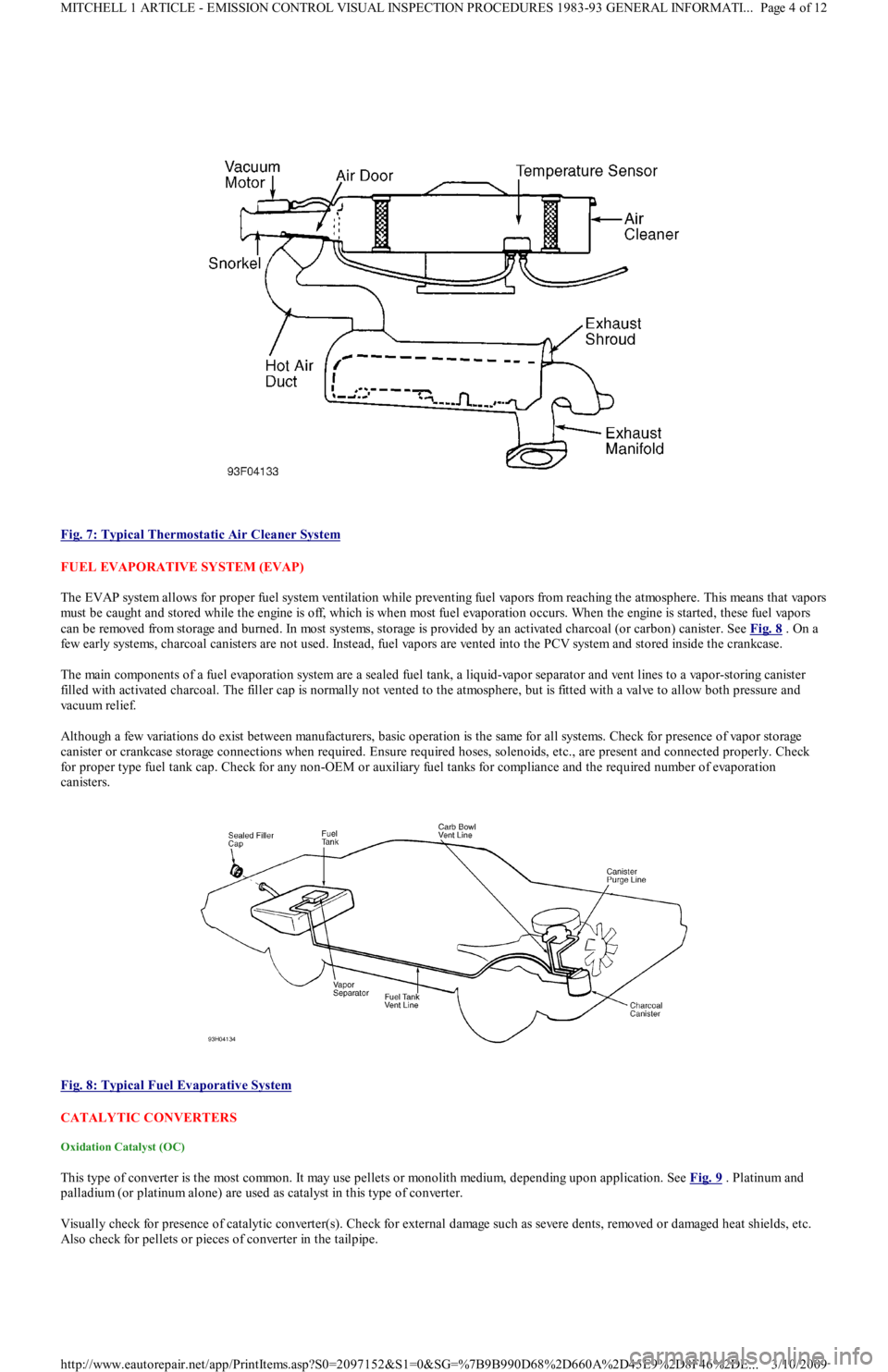
Fig. 7: Typical Thermostatic Air Cleaner System
FUEL EVAPORATIVE SYSTEM (EVAP)
The EVAP system allows for proper fuel system ventilation while preventing fuel vapors from reaching the atmosphere. This means that vapors
must be caught and stored while the engine is off, which is when most fuel evaporation occurs. When the engine is started, these fuel vapors
can be removed from storage and burned. In most systems, storage is provided by an activated charcoal (or carbon) canister. See Fig. 8
. On a
few early systems, charcoal canisters are not used. Instead, fuel vapors are vented into the PCV system and stored inside the crankcase.
The main components of a fuel evaporation system are a sealed fuel tank, a liquid-vapor separator and vent lines to a vapor-storing canister
filled with activated charcoal. The filler cap is normally not vented to the atmosphere, but is fitted with a valve to allow both pressure and
vacuum relief.
Although a few variations do exist between manufacturers, basic operation is the same for all systems. Check for presence of vapor storage
canister or crankcase storage connections when required. Ensure required hoses, solenoids, etc., are present and connected properly. Check
for proper type fuel tank cap. Check for any non-OEM or auxiliary fuel tanks for compliance and the required number of evaporation
canisters.
Fig. 8: Typical Fuel Evaporative System
CATALYTIC CONVERTERS
Oxidation Catalyst (OC)
This type of converter is the most common. It may use pellets or monolith medium, depending upon application. See Fig. 9 . Platinum and
palladium (or platinum alone) are used as catalyst in this type of converter.
Visually check for presence of catalytic converter(s). Check for external damage such as severe dents, removed or damaged heat shields, etc.
Also check for pellets or pieces of converter in the tailpipe.
Page 4 of 12 MITCHELL 1 ARTICLE - EMISSION CONTROL VISUAL INSPECTION PROCEDURES 1983-93 GENERAL INFORMATI
...
3/10/2009 http://www.eautorepair.net/app/PrintItems.asp?S0=2097152&S1=0&SG=%7B9B990D68%2D660A%2D45E9%2D8F46%2DE
...
Page 265 of 454
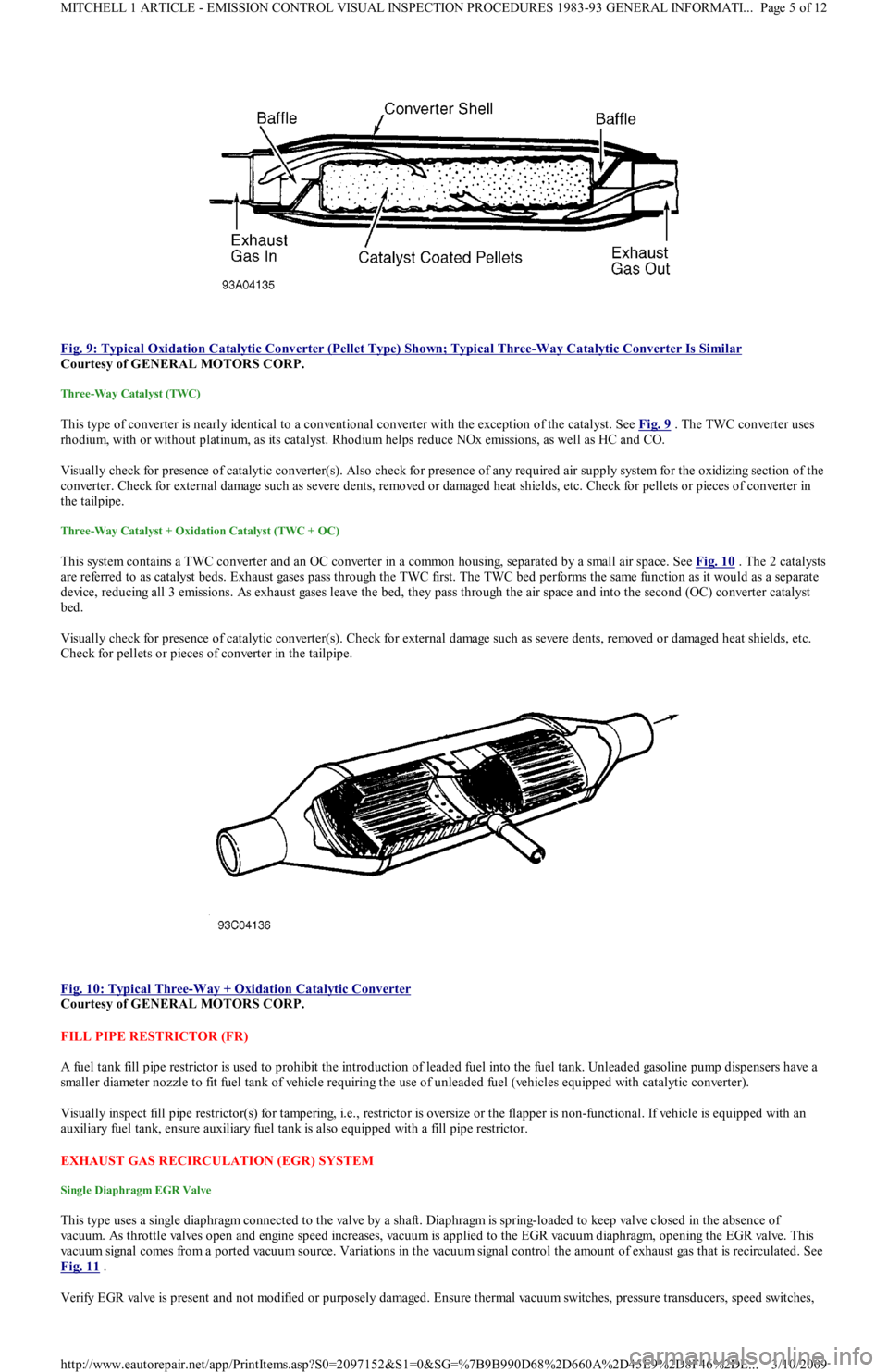
Fig. 9: Typical Oxidation Catalytic Converter (Pellet Type) Shown; Typical Three
-Way Catalytic Converter Is Similar
Courtesy of GENERAL MOTORS CORP.
Three-Way Catalyst (TWC)
This type of converter is nearly identical to a conventional converter with the exception of the catalyst. See Fig. 9 . The TWC converter uses
rhodium, with or without platinum, as its catalyst. Rhodium helps reduce NOx emissions, as well as HC and CO.
Visually check for presence of catalytic converter(s). Also check for presence of any required air supply system for the oxidizing section of the
converter. Check for external damage such as severe dents, removed or damaged heat shields, etc. Check for pellets or pieces of converter in
the tailpipe.
Three-Way Catalyst + Oxidation Catalyst (TWC + OC)
This system contains a TWC converter and an OC converter in a common housing, separated by a small air space. See Fig. 10. The 2 catalysts
are referred to as catalyst beds. Exhaust gases pass through the TWC first. The TWC bed performs the same function as it would as a separate
device, reducing all 3 emissions. As exhaust gases leave the bed, they pass through the air space and into the second (OC) converter catalyst
bed.
Visually check for presence of catalytic converter(s). Check for external damage such as severe dents, removed or damaged heat shields, etc.
Check for pellets or pieces of converter in the tailpipe.
Fig. 10: Typical Three
-Way + Oxidation Catalytic Converter
Courtesy of GENERAL MOTORS CORP.
FILL PIPE RESTRICTOR (FR)
A fuel tank fill pipe restrictor is used to prohibit the introduction of leaded fuel into the fuel tank. Unleaded gasoline pump dispensers have a
smaller diameter nozzle to fit fuel tank of vehicle requiring the use of unleaded fuel (vehicles equipped with catalytic converter).
Visually inspect fill pipe restrictor(s) for tampering, i.e., restrictor is oversize or the flapper is non-functional. If vehicle is equipped with an
auxiliary fuel tank, ensure auxiliary fuel tank is also equipped with a fill pipe restrictor.
EXHAUST GAS RECIRCULATION (EGR) SYSTEM
Single Diaphragm EGR Valve
This type uses a single diaphragm connected to the valve by a shaft. Diaphragm is spring-loaded to keep valve closed in the absence of
vacuum. As throttle valves open and engine speed increases, vacuum is applied to the EGR vacuum diaphragm, opening the EGR valve. This
vacuum signal comes from a ported vacuum source. Variations in the vacuum signal control the amount of exhaust gas that is recirculated. See
Fig. 11
.
Verify EGR valve is present and not modified or purposely damaged. Ensure thermal vacuum switches, pressure transducers, speed switches,
Page 5 of 12 MITCHELL 1 ARTICLE - EMISSION CONTROL VISUAL INSPECTION PROCEDURES 1983-93 GENERAL INFORMATI
...
3/10/2009 http://www.eautorepair.net/app/PrintItems.asp?S0=2097152&S1=0&SG=%7B9B990D68%2D660A%2D45E9%2D8F46%2DE
...
Page 266 of 454
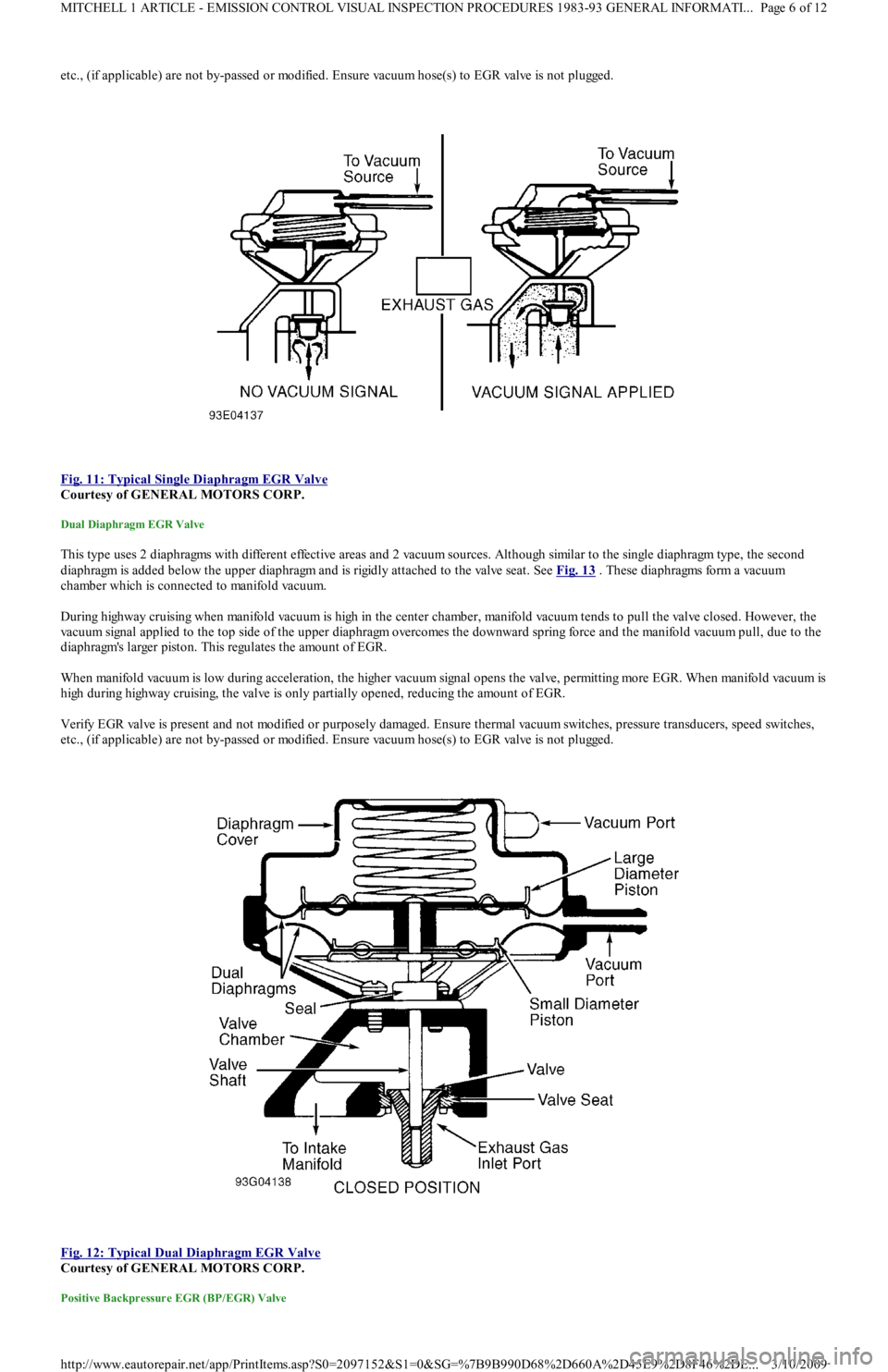
etc., (if applicable) are not by-passed or modified. Ensure vacuum hose(s) to EGR valve is not plugged.
Fig. 11: Typical Single Diaphragm EGR Valve
Courtesy of GENERAL MOTORS CORP.
Dual Diaphragm EGR Valve
This type uses 2 diaphragms with different effective areas and 2 vacuum sources. Although similar to the single diaphragm type, the second
diaphragm is added below the upper diaphragm and is rigidly attached to the valve seat. See Fig. 13
. These diaphragms form a vacuum
chamber which is connected to manifold vacuum.
During highway cruising when manifold vacuum is high in the center chamber, manifold vacuum tends to pull the valve closed. However, the
vacuum signal applied to the top side of the upper diaphragm overcomes the downward spring force and the manifold vacuum pull, due to the
diaphragm's larger piston. This regulates the amount of EGR.
When manifold vacuum is low during acceleration, the higher vacuum signal opens the valve, permitting more EGR. When manifold vacuum is
high during highway cruising, the valve is only partially opened, reducing the amount of EGR.
Verify EGR valve is present and not modified or purposely damaged. Ensure thermal vacuum switches, pressure transducers, speed switches,
etc., (if applicable) are not by-passed or modified. Ensure vacuum hose(s) to EGR valve is not plugged.
Fig. 12: Typical Dual Diaphragm EGR Valve
Courtesy of GENERAL MOTORS CORP.
Positive Backpressure EGR (BP/EGR) Valve
Page 6 of 12 MITCHELL 1 ARTICLE - EMISSION CONTROL VISUAL INSPECTION PROCEDURES 1983-93 GENERAL INFORMATI
...
3/10/2009 http://www.eautorepair.net/app/PrintItems.asp?S0=2097152&S1=0&SG=%7B9B990D68%2D660A%2D45E9%2D8F46%2DE
...
Page 267 of 454
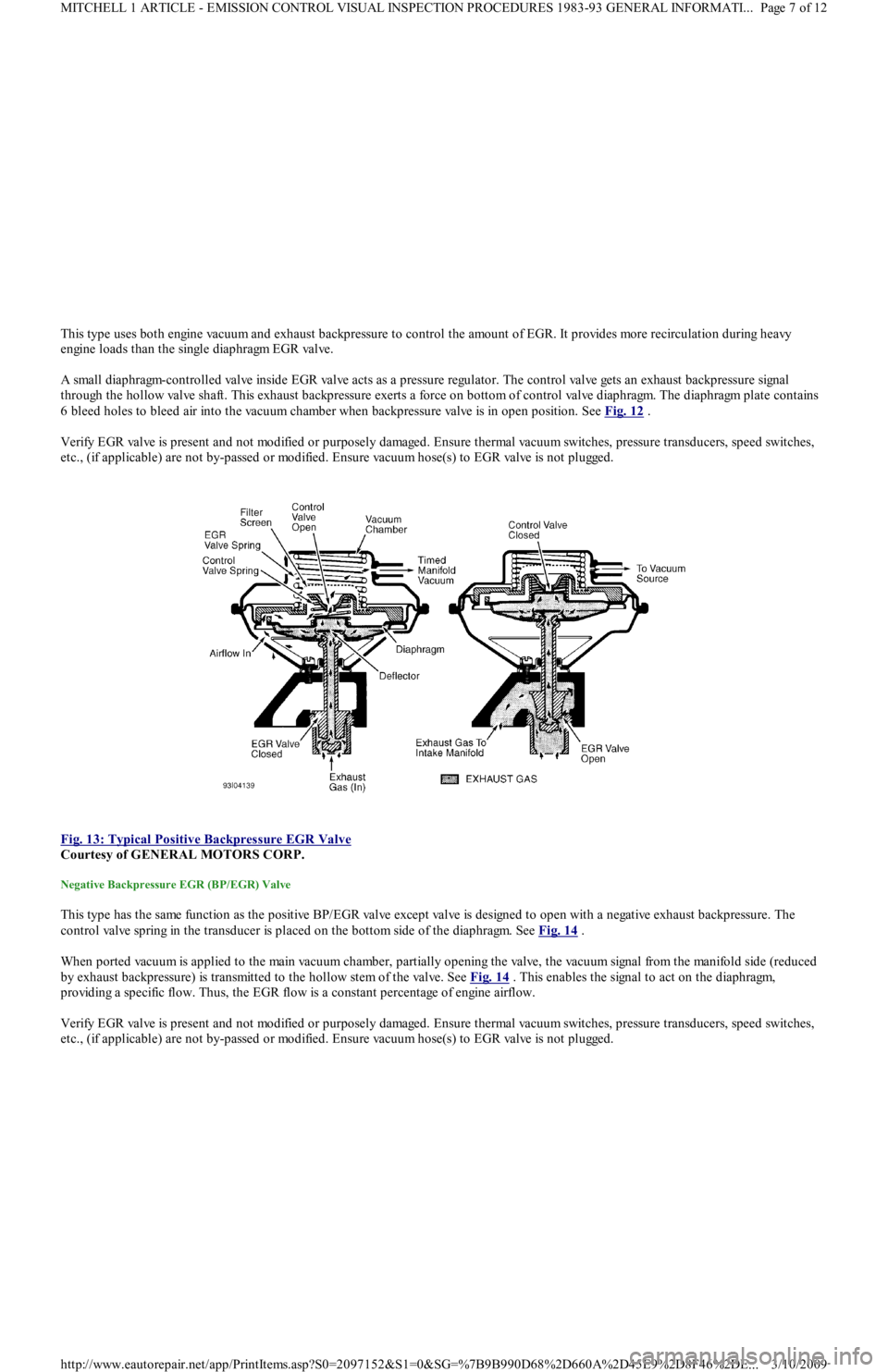
This type uses both engine vacuum and exhaust backpressure to control the amount of EGR. It provides more recirculation during heavy
engine loads than the single diaphragm EGR valve.
A small diaphragm-controlled valve inside EGR valve acts as a pressure regulator. The control valve gets an exhaust backpressure signal
through the hollow valve shaft. This exhaust backpressure exerts a force on bottom of control valve diaphragm. The diaphragm plate contains
6 bleed holes to bleed air into the vacuum chamber when backpressure valve is in open position. See Fig. 12
.
Verify EGR valve is present and not modified or purposely damaged. Ensure thermal vacuum switches, pressure transducers, speed switches,
etc., (if applicable) are not by-passed or modified. Ensure vacuum hose(s) to EGR valve is not plugged.
Fig. 13: Typical Positive Backpressure EGR Valve
Courtesy of GENERAL MOTORS CORP.
Negative Backpressure EGR (BP/EGR) Valve
This type has the same function as the positive BP/EGR valve except valve is designed to open with a negative exhaust backpressure. The
control valve spring in the transducer is placed on the bottom side of the diaphragm. See Fig. 14
.
When ported vacuum is applied to the main vacuum chamber, partially opening the valve, the vacuum signal from the manifold side (reduced
by exhaust backpressure) is transmitted to the hollow stem of the valve. See Fig. 14
. This enables the signal to act on the diaphragm,
providing a specific flow. Thus, the EGR flow is a constant percentage of engine airflow.
Verify EGR valve is present and not modified or purposely damaged. Ensure thermal vacuum switches, pressure transducers, speed switches,
etc., (if applicable) are not by-passed or modified. Ensure vacuum hose(s) to EGR valve is not plugged.
Page 7 of 12 MITCHELL 1 ARTICLE - EMISSION CONTROL VISUAL INSPECTION PROCEDURES 1983-93 GENERAL INFORMATI
...
3/10/2009 http://www.eautorepair.net/app/PrintItems.asp?S0=2097152&S1=0&SG=%7B9B990D68%2D660A%2D45E9%2D8F46%2DE
...
Page 268 of 454

Fig. 14: Typical Negative Backpressure EGR Valve
Courtesy of GENERAL MOTORS CORP.
Digital EGR Valve
The digital EGR valve operates independently of engine manifold vacuum. This valve controls EGR flow through 3 orifices. These 3 orifices
are opened and closed by electric solenoids. The solenoids are, in turn, controlled by the Electronic Control Module (ECM). When a
solenoid is energized, the armature with attached shaft and swivel pintle is lifted, opening the orifice. See Fig. 15
.
The ECM uses inputs from the Coolant Temperature Sensor (CTS), Throttle Position Sensor (TPS) and Mass Airflow (MAF) sensors to
control the EGR orifices to make 7 different combinations for precise EGR flow control. At idle, the EGR valve allows a very small amount of
exhaust gas to enter the intake manifold. This EGR valve normally operates above idle speed during warm engine operation.
Verify EGR valve is present and not modified or purposely damaged. Ensure thermal vacuum switches, pressure transducers, speed switches,
etc., (if applicable) are not by-passed or modified. Ensure vacuum hose(s) to EGR valve is not plugged. Ensure electrical connector to EGR
valve is not disconnected.
Page 8 of 12 MITCHELL 1 ARTICLE - EMISSION CONTROL VISUAL INSPECTION PROCEDURES 1983-93 GENERAL INFORMATI
...
3/10/2009 http://www.eautorepair.net/app/PrintItems.asp?S0=2097152&S1=0&SG=%7B9B990D68%2D660A%2D45E9%2D8F46%2DE
...
Page 269 of 454
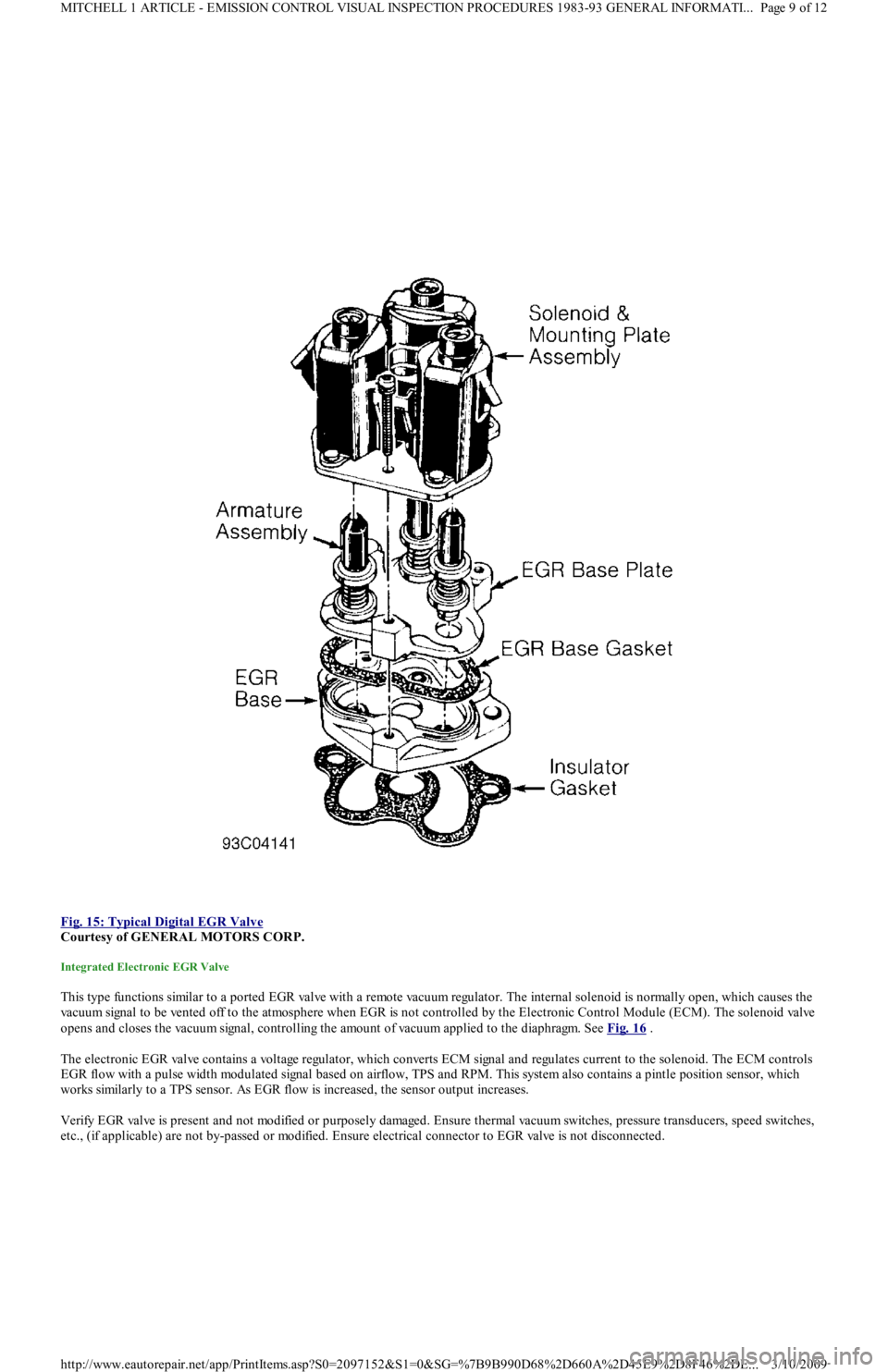
Fig. 15: Typical Digital EGR Valve
Courtesy of GENERAL MOTORS CORP.
Integrated Electronic EGR Valve
This type functions similar to a ported EGR valve with a remote vacuum regulator. The internal solenoid is normally open, which causes the
vacuum signal to be vented off to the atmosphere when EGR is not controlled by the Electronic Control Module (ECM). The solenoid valve
opens and closes the vacuum signal, controlling the amount of vacuum applied to the diaphragm. See Fig. 16
.
The electronic EGR valve contains a voltage regulator, which converts ECM signal and regulates current to the solenoid. The ECM controls
EGR flow with a pulse width modulated signal based on airflow, TPS and RPM. This system also contains a pintle position sensor, which
works similarly to a TPS sensor. As EGR flow is increased, the sensor output increases.
Verify EGR valve is present and not modified or purposely damaged. Ensure thermal vacuum switches, pressure transducers, speed switches,
etc., (if applicable) are not by-passed or modified. Ensure electrical connector to EGR valve is not disconnected.
Page 9 of 12 MITCHELL 1 ARTICLE - EMISSION CONTROL VISUAL INSPECTION PROCEDURES 1983-93 GENERAL INFORMATI
...
3/10/2009 http://www.eautorepair.net/app/PrintItems.asp?S0=2097152&S1=0&SG=%7B9B990D68%2D660A%2D45E9%2D8F46%2DE
...
Page 270 of 454
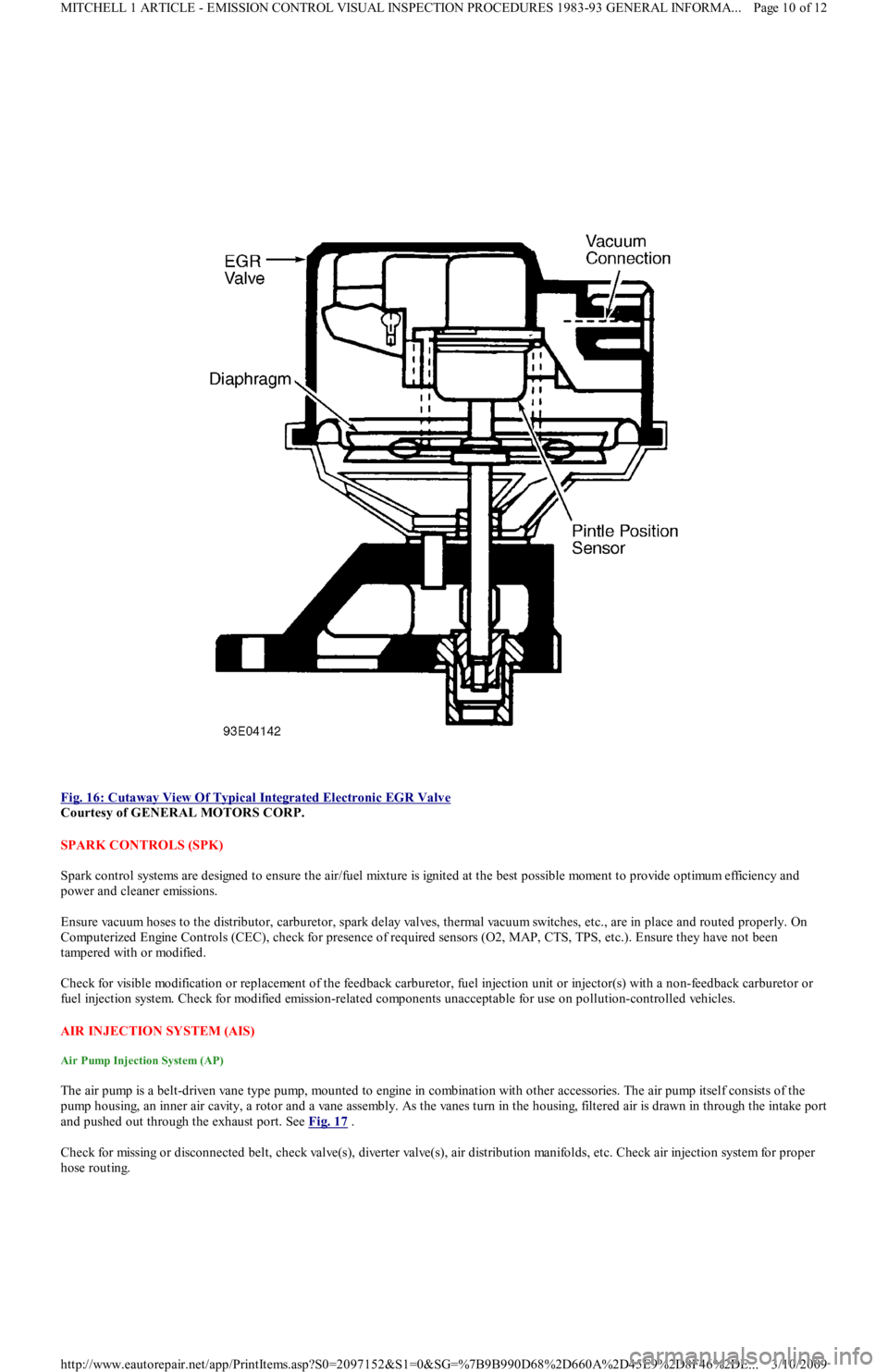
Fig. 16: Cutaway View Of Typical Integrated Electronic EGR Valve
Courtesy of GENERAL MOTORS CORP.
SPARK CONTROLS (SPK)
Spark control systems are designed to ensure the air/fuel mixture is ignited at the best possible moment to provide optimum efficiency and
power and cleaner emissions.
Ensure vacuum hoses to the distributor, carburetor, spark delay valves, thermal vacuum switches, etc., are in place and routed properly. On
Computerized Engine Controls (CEC), check for presence of required sensors (O2, MAP, CTS, TPS, etc.). Ensure they have not been
tampered with or modified.
Check for visible modification or replacement of the feedback carburetor, fuel injection unit or injector(s) with a non-feedback carburetor or
fuel injection system. Check for modified emission-related components unacceptable for use on pollution-controlled vehicles.
AIR INJECTION SYSTEM (AIS)
Air Pump Injection System (AP)
The air pump is a belt-driven vane type pump, mounted to engine in combination with other accessories. The air pump itself consists of the
pump housing, an inner air cavity, a rotor and a vane assembly. As the vanes turn in the housing, filtered air is drawn in through the intake port
and pushed out through the exhaust port. See Fig. 17
.
Check for missing or disconnected belt, check valve(s), diverter valve(s), air distribution manifolds, etc. Check air injection system for proper
hose routing.
Page 10 of 12 MITCHELL 1 ARTICLE - EMISSION CONTROL VISUAL INSPECTION PROCEDURES 1983-93 GENERAL INFORMA...
3/10/2009 http://www.eautorepair.net/app/PrintItems.asp?S0=2097152&S1=0&SG=%7B9B990D68%2D660A%2D45E9%2D8F46%2DE
...